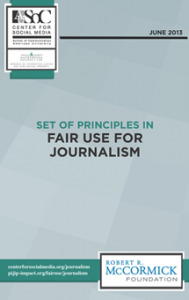 [Reposted from pijip-impact.org] This document is a statement of principles to help journalists in the United States interpret the copyright doctrine of fair use. It is intended for anyone who engages in the set of practices that entails creating media of any kind that refers to real-life events of public interest, in service of public knowledge, whether that person is a full-time professional or an individual who takes it upon himself or herself to report about specific issues or events. In other words, the definition of “journalism” to which this document speaks is defined by acts, not titles, and is an inclusive one, reflecting (in part) the changing nature of the technologies that support and enable journalistic practice.
[Reposted from pijip-impact.org] This document is a statement of principles to help journalists in the United States interpret the copyright doctrine of fair use. It is intended for anyone who engages in the set of practices that entails creating media of any kind that refers to real-life events of public interest, in service of public knowledge, whether that person is a full-time professional or an individual who takes it upon himself or herself to report about specific issues or events. In other words, the definition of “journalism” to which this document speaks is defined by acts, not titles, and is an inclusive one, reflecting (in part) the changing nature of the technologies that support and enable journalistic practice.
The project was coordinated by American University Professors Peter Jaszi (Program on Information Justice and Intellectual Property, Washington College of Law) and Patricia Aufderheide (Center for Social Media, School of Communication).
FULL REPORT: Set of Principles in Fair Use for Journalism
Organizations Endorsing the Principles:
- Association for Education in Journalism and Mass Communication
- Association of Schools of Journalism and Mass Communication
- Association of Alternative Newsweeklies
- J-Lab
- Mediashift
- NABJ Digital Journalism Task Force
- National Lesbian & Gay Journalists Association
- New America Media
- Poynter Institute
- Robert R. McCormick Foundation
Additional Resources:
- Frequently Asked Questions on Fair Use for Journalism
- Fair Use and Journalism: You Be the Judge!
- American University Center for Social Media
What people are saying about the Principles:
“What makes this set of principles stand out is the depth and breadth of research that informed their creation. The thoughtfulness put into the process for creating the guidelines is an example of best practice in and of itself. This set of principles is a important resource that helps content creators navigate one of the more complex areas of copyright law.”
– Ellyn Angelotti, Esq., Faculty, Digital Trends and Social Media
Poynter Institute for Media Studies
“We look forward to working with our member organizations to empower them with this Set of Principles. It will help them make decisions about their own unlicensed uses more efficiently and with greater confidence, and it will also allow them to understand when they should challenge others’ infringing uses of their journalism.”
– Sandy Close, Executive Director
New America Media
“Every web-native journalist needs to know how to use copyright law, and this set of principles reduces risk while encouraging the highest standards in cutting edge journalism.”
– Dave Cohn, Founder/Director, Spot.us
Director of News, Circa
“This set of principles will help reporters and editors use copyright law reasonably and responsibly in the 21st century!”
– Chuck Lewis, Founder/Director, Investigative Reporters Workshop
Professor, American University
“This set of principles helps journalists innovate responsibly, using copyright law with confidence.”
– Geneva Overholser, Director, University of Southern California
Annenberg School of Journalism
“These core principles for fair use of material are so valuable because they are focused on scenarios that journalists confront daily, without even realizing that issues of fair use are involved.”
– Jan Schaffer, Executive Director
J-Lab: The Institute for Interactive Journalism
“This set of principles enables journalism students and scholars, as well as practicing journalists, to use copyright law with confidence—and that serves all of us.”
– Linda Steiner, former President
Association for Education in Journalism and Mass Communication
“I can’t imagine conducting any type of journalism activity in today’s information environment without a thorough understanding of fair use principles. Still, far too many journalists fall into this realm. The Set of Principles in Fair Use for Journalism is vital to securing the legal circulation of original work without negative consequences regarding copyright. It’s part of a revival in fair use thinking and journalists should pay close attention.”
– Kevin Z. Smith-Former Society of Professional Journalists President
Society of Professional Journalists Ethics Chair




